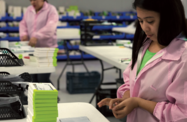Buoyed by a burgeoning middle class and greater availability of financing, the Philippines’ automotive sector is set for strong growth this year, with sales for the usually slow month of August hitting a record high.
New international players are poised to enter the market on the back of growing demand, while the local manufacturing sector is also keen to tap into rising sales by increasing production.
However, both the government and operators will be looking to the long-awaited automotive industry roadmap to drive new growth, through initiatives such as added incentives for investors.
Summer sales boost
In September 2013, the Chamber of Automotive Manufacturers of the Philippines (CAMPI) reported record growth of 21% for automobile sales in August, bucking usual seasonal trends, on the back of high demand for both passenger cars and commercial vehicles.
In a statement, the chamber said combined statistics from the agency and the Truck Manufacturers Association indicated sales reached 13,700 units, up from 11,351 in August 2012. The summer month is traditionally marked by low sales due to lulls in corporate vehicle procurement.
Personal car sales jumped 46.3% to reach 5122 units, up from 3501 in August 2012, while commercial vehicle sales rose from 7850 to 8578 units in a year-on-year (y-o-y) comparison. Combined sales in the eight months from January to August totalled 116,617 units, marking an increase of 18% on the same period last year.
CAMPI president, Rommel Gutierrez, told local media that the industry looked likely to reach its sales targets for 2013 of 210,000 units, which represents 15% overall growth, on the back of a solid performance to date.
Industry players are convinced that wider availability of financing has played a key role in driving up sales.
“Financing has been the main engine for growth in car sales due to lower interest rates post-investment upgrade, and banks are a lot more eager to partner with car dealerships,” Maricar Parco, CEO of BMW Philippines, told OBG. He added that the ratio of financed auto sales to cash purchases stood at about 80:20.
Market opportunities and challenges
With a 40% market share, Toyota continues to lead the way in the Philippines, recently reporting its highest-ever sales for the Vios model. Consumers purchased 2125 Vios units in August, trumping the company’s previous record of 1760, which it achieved in December 2012. Mitsubishi holds second position, with a 34% market share, followed by Honda (8%).
Toyota could soon face tougher competition, however, as new companies prepare to enter the rapidly expanding market. Volkswagen Philippines, under the umbrella of Ayala Automotive Holdings Corporation, announced plans in August to venture into the Philippines’ market. The company hopes to open its first showroom in Bonifacio Global City in late September. Ayala Holdings already has other automotive investments in the country, including Honda and Isuzu Philippines.
John Philip Orbeta, Chairman and President of Ayala, told local media that the company planned to source vehicles from outside of China, due to the Philippines’ import restrictions. Instead, Ayala will be looking to bring in the VW Beetle model from Mexico and Brazil, with other vehicles set to be supplied by Germany.
Orbeta acknowledged that the lack of a VW manufacturing and distribution hub in the ASEAN market signalled a major challenge for the company.
Indeed, gaps in domestic production pose a problem for industry growth. New data from the ASEAN Automotive Federation (AAF) indicate that while the Philippines is on track to reach its goal of producing 210,000 units this year, the country’s automotive sector still lags behind its ASEAN peers.
Figures released on vehicle production up to the end of July show Philippines output reaching 43,233 units, down 3% year-on-year (y-o-y). In contrast, Thailand produced 1.5m units, while Indonesia’s output reached 692,666. Malaysia and Vietnam, meanwhile, produced 348,303 and 48,092 units respectively.
Challenges facing manufacturers in the Philippines include relatively high electricity and labour costs, making it a less attractive investment destination than some other ASEAN countries.
Government roadmap
Recognising the obstacles that the sector is up against, the government’s Department of Trade and Industry (DTI) is moving to finalise its industry roadmap. In September, trade secretary, Gregory Domingo, said the government was examining incentives aimed at attracting auto manufacturers, which would be based on production and export volumes. The minimum annual output is expected to be 40,000 units, according to Domingo.
The Philippines will be hoping that new foreign players will join companies such as China’s Foton motor, which in 2011 announced plans to invest $20m in a vehicle assembly plant after reaching an agreement with its local distributor, United Asia Automotive Group. Located in Manila, the facility is slated to open in 2014.
Though the roadmap was originally slated for release this summer, the government first plans to hold consultations with stakeholders. Despite the delay, DTI Undersecretary Adrian Cristobal Jr gave an assurance in August that the strategic plan would be released before 2014. Given the key part that the roadmap is expected to play in helping the industry meet local demand and, eventually, create a thriving export market, the government will be keen to avoid unnecessary delays and put the plan into action once the time is right.

